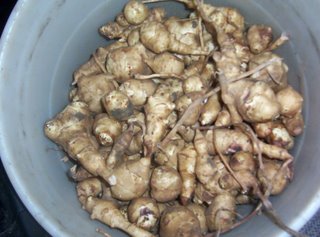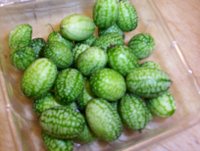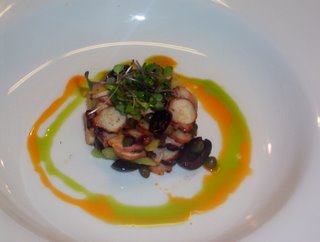Tuesday, October 31, 2006
Happy Halloween
Three Cheers to pumpkin pie, ok, maybe only two then you are bored with it. I suppose the most obvious usages of this wonderful fall squash revolve around toasted pumpkin seeds and a pumpkins soup. I will do my best to stay away from those two ideas while coughing up a few more unique ideas. I’ve made a baked pumpkin and rice custard, where I used pumpkin puree, a few egg yolks, and cooked rice, all mixed up and baked for 20 minutes, it turned out rather well when I spread some toasted nuts over top. I have made a special risotto over the past few years where I shred some pumpkin and cook it right with the arborio rice to make Pumpkin Risotto, I use apple cider as the cooking liquid so it’s a vegetarian option until the butter and cheese at the end, oh you devil. You can cook down your pumpkin just like you are making apple butter, over very slow heat, until the liquid is almost all gone, then add some sweetener and save that for your bagel. It will never get as tight as apple butter without pectin, or try adding a few apples in, I’ve not tied that yet. Well, I wasn’t about to tackle chocolate, so here is my ode to Halloween.
Friday, October 27, 2006
The Good Times Are Killing Me

Well, in retrospect it was a very subdue friday night. Sometimes you just need to have some fun, and being around food leads to only one thing......fun with food. So my new Italian Pizza Chef, Forest comes with high credatials, zeppolli here, mortadella there, he is from Rome, so we expect it, but he was not sure exactly how funny we Americans think pizza dough on the ceiling falling on someones head can be. Well, he showed us some things.

The fact of the matter is, when you work hard, you get time to joke around and have fun, and although those times are far and few between, they are cherished. So is a job well done cherished, and a job well done half way through my shift looks something like this.....

Enough esspresso to make your stomach turn, a sharp knife, and full cambro containers. It's like a dream I had one time.
Ode to a good friday!!!
Thursday, October 26, 2006
Specials for October 27, 2006
Wednesday, October 25, 2006
Sunchoke

It was my pleasure to visit Ms. And Mr. Engel today in Westlake where they offered up a sizable bucket of Sunchokes. The Engels enjoy the flowering plant during the summer, and benefit from the underground bounty at the end of the warm seasons. Fortunately, the plants flourished, and they were able to share with me some of their homegrown Sunchokes.
Sunchokes might also be called sunroot, or Jerusalem Artichoke.
The name Jerusalem is due to folk etymology; when the Jerusalem artichoke was first discovered it was called Girasole, the Italian word for sunflower, as the plant is in fact part of the sunflower family. Over time the Girasole transformed into Jerusalem and since the root only faintly tastes of Artichokes, myself and most culinarians have recently started referring to the root as Sunchoke Sunchoke while still unique to the plates of most restaurant the plants are an important source of fructose for industry as they store carbohydrates as inulin instead of starch. The result is a very crisp and juicy root, the skin is completely edible when washed sufficiently. The easiest comparison is between sunchoke and jicama, with a shot of earthiness.

Mr. Engel urged me to put some Sunchoke in when making a pot roast. He told me as a flavoring only, they tend not to enjoy the soft, pastiness that is a result of a long cooking. Due to the fact the sunchoke breaks down thoroughly it is perfect for making a creamy soup. I like to take equal parts sunchoke and rutabaga, lay that over a few sauteed onions, cover with chicken stock, and when everything is soft, we blend it smooth. As Mr. Engle pointed out, the flavor of the sunchoke pairs well with red meat. I like to put a nice pat of butter down, and cook the cut Sunchoke on a rather high heat watching carefully not to burn the butter, while paying attention so the sunchoke doesn’t turn mushy. These caramelized Sunchoke are perfect with a grilled steak and mushrooms. The most refreshing way I’ve come to use sunchokes is part of a raw salad. You need a sharp mandolin as the sunchoke needs to be thinly sliced, then we cover it with a generous portion of lime juice, some chop bell pepper, olive oil, and a dash of hot sauce.
I really enjoy the unique flavor of sunchokes, they are sweet, earthy, and keep a pleasant texture. Unfortunately, they have a rather short shelf life, and I have not yet found any decant products that didn’t come from local farmers. I am very thankful to the Engles, as well as Ed and Betty Frank from Veggie Valley Farms in Sunnyville, Ohio. Ed and Betty brought me the absolute most wonderful sunchokes last year, and I couldn’t wait to get my hands on them again. I’m currently using them in my weekly specials, but they don’t last long.
Tuesday, October 24, 2006
Cookbooks
Well, I’ve been considering a blog entry in the, "get to know you by way of a list" vain. Until I knocked the sizeable stack of cookbooks off my desk I just wasn’t sure what kind of list. What is your favorite cookbook is an eventual question when any cook gets interrogated by his non-cooking peers, so I’ll give up the information easily. Now consider, these are only the books within 3 feet of my here on the computer, and I’ll list them from furthest away, to closest.
Tetsuya, by Tetsuya Wakuda
Chinese Cooking, by Ken Hom
Simple to Spectacular, by Jean-George
Larousse Gastronomique
Charlie Trotters
Think Like a Chef, by Tom Colicchio
Rockenwagner, by Hans Rachenwagner
Famie’s Adventures in Cooking, by Keith Famie
Heartland, The Best of Midwestern Kitchens, by Marcia Adams
Adkins for Life, by Dr. Adkins
Vegetables from Amaranth to Zucchini, by Elizabeth Schneider
Culinary Artistry, by Dornenburg and Page
Charcuterie, by Ruhlman and Polcyn
Art Culinaire periodical

Wow, that is quite an impressive list I didn’t even realize, in fact I forgot I even owned some of those titles.
I don’t think that how many, or which cookbooks you own is very important, rather how you use the cookbooks that you do have. For me, cookbooks work in two ways, as basic reference for things that we should know, but haven’t committed to memory, but most importantly we know where to find such information. For instance, how many eggs in a custard, how much gelatine in a liquid, how much butter per egg for hollandaise. The second way to use a cookbook is for inspiration. Imitation is not inspiration. I often find a picture, or a description of how an ingredient tastes, or it’s origin to be very inspirational when thinking creatively about food. Even the most mundane food get’s re-invented by an old cookbook, an old recipe or an explanation about a certain foods role in history
Tetsuya, by Tetsuya Wakuda
Chinese Cooking, by Ken Hom
Simple to Spectacular, by Jean-George
Larousse Gastronomique
Charlie Trotters
Think Like a Chef, by Tom Colicchio
Rockenwagner, by Hans Rachenwagner
Famie’s Adventures in Cooking, by Keith Famie
Heartland, The Best of Midwestern Kitchens, by Marcia Adams
Adkins for Life, by Dr. Adkins
Vegetables from Amaranth to Zucchini, by Elizabeth Schneider
Culinary Artistry, by Dornenburg and Page
Charcuterie, by Ruhlman and Polcyn
Art Culinaire periodical

Wow, that is quite an impressive list I didn’t even realize, in fact I forgot I even owned some of those titles.
I don’t think that how many, or which cookbooks you own is very important, rather how you use the cookbooks that you do have. For me, cookbooks work in two ways, as basic reference for things that we should know, but haven’t committed to memory, but most importantly we know where to find such information. For instance, how many eggs in a custard, how much gelatine in a liquid, how much butter per egg for hollandaise. The second way to use a cookbook is for inspiration. Imitation is not inspiration. I often find a picture, or a description of how an ingredient tastes, or it’s origin to be very inspirational when thinking creatively about food. Even the most mundane food get’s re-invented by an old cookbook, an old recipe or an explanation about a certain foods role in history
Monday, October 23, 2006
Spring Wine Dinner Revisited
 Fahrenheit Restaurant
Fahrenheit RestaurantPatz&Hall Winery
May 2006
Amuse
Kona Kompachi TarTar wrapped in Grilled Carrot, roasted garlic ponzu, Chef's Garden Micro Lemongrass
First Course
Copper River King Salmon, Fiddlehead ferns, Toasted Pecans, Chef's Garden Spring Lettuce, Applewood Smoked Bacon Vinaigrette
Second Course
Chef’s Garden Asparagus, Poached Farmers Egg, Truffle Hollandaise, Blood Orange Syrup

Third Course
Quail Breast, Morel mushrooms stuffed with Quail leg confit and Veal Sweetbreads, Green
 Tomato Marmalade, Morel mushroom stew, Chef's Garden Popcorn shoots
Tomato Marmalade, Morel mushroom stew, Chef's Garden Popcorn shootsFourth Course
Roasted Leg of Spring Lamb, Puree of Flagolet beans, English Pea Flan, Rosemary Veal Reduction
Fifth Course
Cheese Course
Sixth Course
Petit Fours
Sunday, October 22, 2006
Where did grandma's food come from?
It was quite a pleasure this past week meeting the cheese maker at the newly establish Lake Erie Creamery. After exchanging pleasantries, and assessing the honest goodness that their artisan goat cheese poses, we struck up a conversation about local farmers markets. We concluded that there is in fact the North Union Farmers Market at Shaker Square all year long, but right about this time of the year, the fresh local produce almost disappears. Gone are the tomatoes, melons, peaches, salad greens, onions, broccoli, garlic, even potatoes and hard squashes are a wisp away. A short discussion concerning the recent E. Coli events, lead us to the dismal reality that we will be going back to the supermarket and purchasing fresh produce from god knows where. I had to ask myself at this point, "Where did great-grandma get here food from?" When winter settles in, and there is no supermarket, no air-chilled asparagus on an overnight flight from Chili. What did she eat, what did she cook, and what would she think about our current desire to buy locally, or at least when it’s convenient. I think she would laugh at us, and rightfully so.
Friday, October 20, 2006
Tomato Season is Over
 It just might come as a suprise to some, since we have all seen snow flakes in the air, but local tomatoes are no longer available. Good-bye local gems, grown by good people, on honest land, with their own hard work. Good-bye dime sized tomatos and good-bye football sized ones, good-bye fresh tasting, dirty, not always round jewels. We will see you again, only 8 months away, and we will be even more excited about our localy grown beauties then, more proud and more trusting in the truthfull goodness of our very own Ohio tomatoes.
It just might come as a suprise to some, since we have all seen snow flakes in the air, but local tomatoes are no longer available. Good-bye local gems, grown by good people, on honest land, with their own hard work. Good-bye dime sized tomatos and good-bye football sized ones, good-bye fresh tasting, dirty, not always round jewels. We will see you again, only 8 months away, and we will be even more excited about our localy grown beauties then, more proud and more trusting in the truthfull goodness of our very own Ohio tomatoes.
Specials for October 20, 2006

Amuse: Raw Sunchoke Salad, Mouse Melons, Chili Oil
Soup: Celery Root and Foie Gras Bisque
App: Butternut Squash Rissotto, Chantrelle Mushrooms, Rosemary-Goat Cheese Cream

Entree: Duo of Wild Boar. Boar Shoulder Confit on a Pumpin Tart with poached Cranberries, Grilled Boar T-bone on carmalized Sunchokes with toasted Chufa Nuts.
Pronounced [CHOO-fuh], the tiny, tuberous roots of a Middle-Eastern plant of the sedge family, chufa "nuts" have their origin in ancient Egypt. Chufa was one of the first domesticated crops and in fact, was found in vases in the tombs of the ancient Egyptian pharos. The chufa nut was widely used in Egypt and Sudan. The Arabs introduced the plant to Spain during the time of the Moorish kings (700 B.C. a 1200 A.D.). The eastern Spanish province of Valencia was the best for growing chufa.The nut is good for your health, with high levels of iron and potassium. It does not contain sodium and is valued for its minerals and vitamins.
Mouse Melon is also known as Mexican Sour Cucumber, and Cucamelon. It is a member of the melon family, and grows on mostly decrative vines. While native to South America, the decrative plant as spread into North America and as a second thought the fruit. The fruit tastes something like the white part of the watermelon mixed with the seeds of a cucumber.
Subscribe to:
Posts (Atom)

